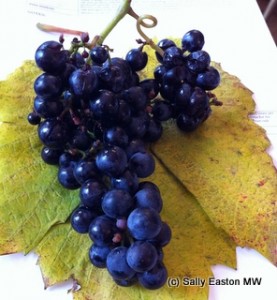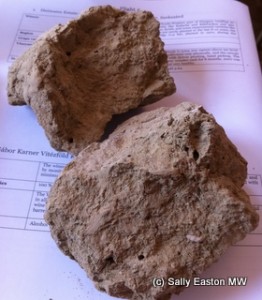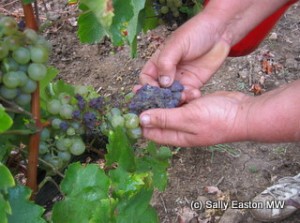Austro-Hungarian tasting in London
In October 2010, the Institute of Masters of Wine hosted a tasting of wines from contiguous nations Austria and Hungary, which, both being niche producers (their combined production is about 1/8th that of France), decided to collaboratively present their wines.

Blaufränkisch / kékfrankos
The red flight, all made from the same grape variety, called blaufränkisch in Austria and kékfrankos in Hungary (as it happens, also known as lemberger in Germany), and the sweet flight, from each country’s classic botryitised wines, both made perfect comparative sense.
But the white flight was an unfair match, pitting Hungary’s Somló region against Austria’s Wachau. The old volcanic Somló Hill may provide the origin of that region’s best wines, but the ancient primary rock and steep slopes of Wachau viticulture produce more interesting wines. Added to which, the typical grape varieties grown in Somló – furmint, hárslevelű and olaszrisling – are significantly different from Wachau’s globally-lauded grüner veltliner and riesling.
The Hungarian flight of reds came from four different regions across the country, whilst the Austrians showed the diversity of blaufränkisch across Burgenland.
Blaufränkisch has been developing quietly and successfully as Austria’s flagship red, and in Hungary kékfrankos is the country’s most widely planted red grape variety. In both countries it is made into both blended and single varietal wines. Fruits of the forest and a rich spiciness of flavour are keynotes of the variety.
If the evidence of this tasting is anything to go by, it’s proving itself to be adaptable to a variety of sites and soils. Soils varied from rocky loess in Szekszárd, to volcanic andesite in Mátra, to gneiss in Sopron and back to volcanic in Eger, which region neighbours Mátra. In Austria, notable temperature differences exist between the south and north of Burgenland, with cooler fruit evident in the south. Soils varied from loam and slate in the south, through clay over shell-limestone, to mica-schist in Leithaberg.

Rocky loess
Silvia Prieler of Weingut Prieler said the diversity of blaufränkisch/kékfrankos styles is “because of different soils. If you plant blaufränkisch on the wrong soil it can have acidity and nothing else, it can be a bit challenging. You need to have clay and rocks for blaufränkisch”, adding “30-35hl/ha is good for quality because it’s a later ripener.”
For the sweets, as one would expect, the botrytis bonanza overrode varietal individuality, whose fundamental contribution is necessarily acidity to balance the lush, spicily-textured botrytis flavours. Thus the Tokajis were all about 70% furmint with the balance of the more aromatic hárslevelű, although six grape varieties are allowed. On the Austrian side, there is more flexibility of grape variety, with each of the examples shown being from different single grape varieties.
Aszu berries, harvested one by one, are the gold dust of Tokaji. “If they are over-aged in barrel” said Péter Molnár, the general manager of Patricus Winery said, they “lose the nicest aromatics of apricot, peach, mango and quince.”

Aszu berries
In Austria sweet wines are made on both sides of steppe lake Neusiedlersee. Heidi Schröck, of her eponymous winery on the west side, where botrytis wines have been made for nearly 500 years, said “without the lake, there would be no botrytis wine. It provides humidity. And it keeps the heat of day and releases it overnight.”
Tasting notes, London, October 2010
Indigenous white varieties from Somló and Wachau
Somló Abbey Winery, Olaszrizling 2009. Somló
Straw colour, faint oiliness to the nose, in a good way, steely, mildly floral, rich, dry body of fulsome character. Warmth of alcohol (13.5%) at the end of the palate. Smooth texture. Nicely made and proportioned, but no particular personality. Rather soft palate with hints of sweetness erring towards an off-dry status.
Domaine Kreinbacher, Kőkonyha 2008, Somló
A blend of furmint, harslevelu and olaszrizling.
Straw colour, muted nose, lemon and melon, not so aromatic. Good weight, spiced cream, and fine grainy texture. Warm and rounded texture, but lacking aroma. Nicely balanced, but lacking a little individuality.
Hollóvár Estate, Hárslevelű 2009, Somló
Lemon-spiced cream. The freshest-tasting of the three, warmth of alcohol (14%) quite evident, not so aromatic, with nutty notes coming through the full-bodied, spicy weight.
Domäne Wachau, Grüner Veltliner Weissenkirchen Federspiel 2009, Wachau
Fresh, lemon-creme fraiche. Smooth, silky texture, no massive concentration, in accordance with federspiel, gentle and white pepper spicy, easy to appreciate. Uncomplicated and straightforward with a decent finish.
Weingut Knoll, Grüner Veltliner Loibenberg Smaragd 2007
Quite deep lemon colour. Spicy, muted nose, well defined, big volume, depth and concentration of fruit. Warm, tropical frit, dense and concentrated. Stony, and stone fruit. Elegant with well proportioned body, long finish. Very good.
Domäne Wachau, Riesling Singerriedle Smaragd 2002
Hint of floral petrol emerging on nose, bitumen, honeyed apple, and candied dried pineapple. Rich, concentrated, big volume of fruit. Wafting wood smoke note at back palate from bottle age. Retains some elegance and backbone with age. Mouth-filling, complex, stony, rich, and full; delicious.
Blaufränkisch / kékfrankos: a single red grape variety
Heimann Estate, Baranya-völgyi Kékfrankos 2007, Szekszárd
Medium deep ruby; bright black cherry and tar nose; soft yet crunchy palate, nicely balanced and medium weighted, attractive; alcohol (14%) is entirely integrated. Approachable wine, not too complex, with some attractive length. Very nice.
Gábor Karner, Vitézföld Kékfrankos 2007, Mátra
Medium deep ruby; oily spice of some new oak influence, fine grained, not-quite-gritty tannins. Nicely ripe with some chewiness to the core, though the fresh fruit is (currently?) a bit subdued behind the oak tannins. Otherwise nicely balanced and spicy in a medium weighted style. Needs to soften into itself a bit, but looking good.
Ráspi Estate, Gneis Kékfrankos 2007, Sopron
Medium pale, slightly cloudy (a second bottle was the same) cherry colour; wood-smoke and red cherries, slightly reminiscent of a sweet clone pinot noir. Redcurrant, red cherry, sweet, smooth light tannins. Warmth and sweet fruitiness on the finish, which detracts a little for me.
Imre Kaló, Kékfrankos 2002, Eger
Medium pale ruby; allspice and crushed cherry compote, hint of mulberry at the back. Medium to light body, elegant with lovely, delicate concentration and perfume on the palate. Virtually no age showing. Silky smooth texture, with entirely integrated alcohol (14.4%). A revelation for me. Long, bright red berry fruit flavours. Delicious.
Weingut Krutzler, Blaufränkisch Perwolff 2008, Südburgenland
A 5% dollop of cabernet sauvignon is blended into the blaufränkisch in this wine. Bright, medium deep cherry colour, with a bright, gravelly-graphite nose. There’s a fine chalky note to the fine, young and tight tannins in an elegantly structured whole. Crunchy, bright fruit in a youthful and approachable wine with a long finish.
Weingut Albert Gesellmann, Blaufränkisch Hochberc 2007, Mittelburgenland
Fragrant, wood-smoky, forest-berry fruit nose, warm sweet berries, with youthful, fine -grainy tannins, already mellowing. Medium to full body, erring to rich full body, with rich aromatic spiciness coming through at the end. Smooth mouth-feel, young and well toned, and more than approachable now.
Weingut Esterhazy, Blaufränkisch Föllig 2008, Burgenland
From Leithaberg: the lake (Neusiedlersee) gives heat and humidity, and the hills, up to 400m, offer coolness and freshness. Bright dark cherry colour. Smoky aromatic oakiness, fine grained and chewy, but not overdone, there’s enough fruit to overcome the oak. Red cherry fruits to the fore on the palate. This wine has an international-style feel to it – very clean and modern, with perhaps some idiosyncrasy of individually rubbed away.
Weingut Prieler, Blaufränkisch Goldberg 1999, Burgenland
From Leithaberg. 1999 given as a perfect vintage, to show how blaufränkisch can age.
Warm and fresh berry fruits on the nose. Little real sign of age other than mellow tannins in a rich elegant red-fruit bowl. Just the faintest hint of savoury farmyard. Lovely balance and impression with a long finish. A wholesome and holistic feel to this wine.
Sweet wines of Tokaji and Burgenland
Domaine Disznókő, Tokaji Aszú 6 puttonyos 1999
11.5%, 12.6 g/l TA, 160g/l RS
Amber gold. Complex, oxiditative, nutty, honesuckle, marmalade spectrum, with rich, fresh and tingly acidity. Orange, candied peel, layered, wood-smoke perfume, savoury notes emerging. Delicious, not too sweet perception. Long and complex, but still has freshness.
Patricius Winery, Tokaji Aszú 6 puttonyos 2003
10%, 9.1g/l TA, 185g/l RS
Pale gold, fragrant, muscat-grapey aroma, more fresh fruit, and quite unctuous, bit of lifting VA coming mid-palate. Rich and fully sweet. Lush, luscious. Honeyed, tangerine. Not too much obvious complexity, but could be deceptive, it’s all primary fruit at the moment.
Királyudvar Winery, Tokaji Aszú 6 puttonyos, ‘Lapis Vineyard’ 2005
10%, 11g/l TA, 219g/l RS
Amber-gold, lifting VA, with fat, honeyed, dense, marmalade,. Rich, enveloping sweetness and lushness. Almost full bodied, and with a big, fresh finish, not a hint of cloy. Ripe and dense, young, vibrant. Honeyed, aromatic spicy apricot and quince. Primary fruit to fore.
Heidi Schröck, Furmint Ruster Ausbruch 2007, Burgenland
12%, 8g/l TA, 228 g/l RS. 100% furmint
Lemon gold. Iodine, lifted VA in a complex nose, spicy, nutty, tropical fruit. Dense, fat, tropical sweetness in the core, with freshness along the sides of the tongue. Complex palate, savoury and fruity, tropical, quince, tangerine, many layered and enticing. Very long finish.
Weingut Esterhazy, Welschriesling Trockenbeerenauslese “Kulm” 2004, Burgenland
10.5%, 12 g/l TA, 257 g/l RS. 100% welschriesling
Rich, gold colour; smoky and bright oakiness. Clean and ‘international’, with only modest individuality. Big, fat, a bit more straightforward, with richly honeyed, quince fruits and a fresh finish.
Weingut Kracher, Scheurebe TBA Nr. 11 2006, Neusiedlersee, Burgenland
9%, 7.9 g/l TA, 299 g/l RS. 100% scheurebe.
Golden colour. Bright elderflower aroma on nose. Light and intense nose, and intense palate. Richly fruity, elderflower, perfume, white blossom. Lightness of being with immense concentration. Stunningly good. All fresh, zingy, primary fruit. Long finish.



